Class : Insecta
Order : Hymenoptera
Suborder : Apocrita
Family : Stephanidae
(Also known as Crown wasp)
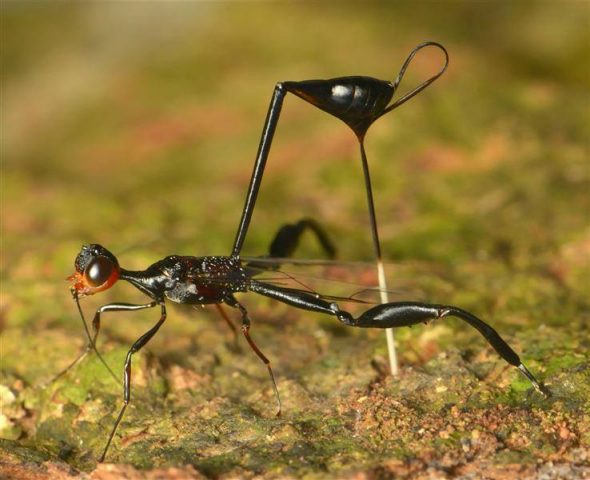
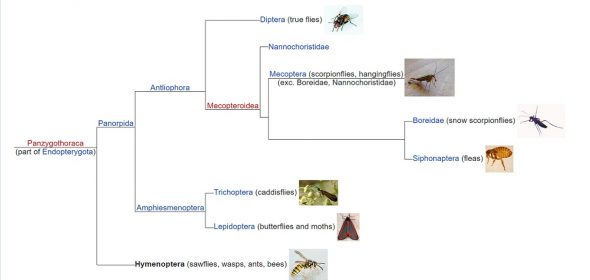
The name Hymenoptera is derived from Greek words which describe the membranous wings of this group of insects.
- The wings are membranous. Ancient Greek ὑμήν (hymen) means membrane.
- The hindwings are connected to the forewings by a series of hooks. The fore and hind wings move as one during flight. Hence, another plausible etymology involves Hymen, the Ancient Greek god of marriage.
Hymenoptera is divided into two sub-orders:
1) Apocrita (narrow waists) – wasps, bees and ants.
2) Symphyta (no waists) – sawflies, horntails and other parasitic wood wasps.
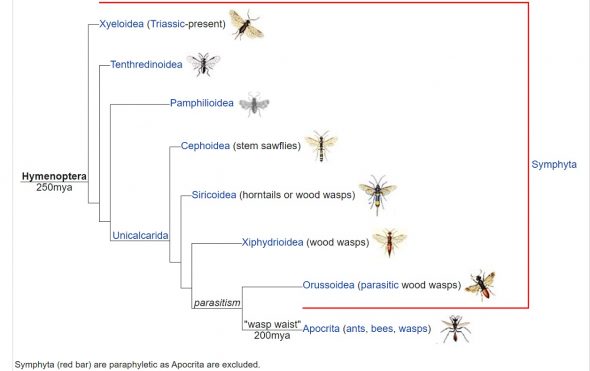
Members of Apocrita group is characterised by a narrowing between the first and second abdominal segments known as the petiole. The first abdominal segment is fused to the thorax. Larva of Apocrita is maggot-like, usually without significant legs and eyes. It also has a blind hind gut. Waste products are kept within the body. Anus only appears when it pupates, so the wastes can be disposed with the larval moults.
Over a hundred thousand species of wasps have been documented, with just as many more waiting to be described. Examples of well-known wasp families are:
Ichneumonidae (25,000 species)
Braconidae (17,000 species)
Chalcididae (22,000 species) and
Stephanidae (350 species).
Some wasps are eusocial (living as a group) e.g. yellow jackets, paper wasps and hornets. Most wasps are solitary. Most solitary wasps are also parasitoids. Their larvae feed on their host (egg, larvae, pupa and adult) and eventually kills it. In other words, they are predators which eat their prey in units of less than one. An ectoparasitoid wasp eats the host from the outside. The host is usually immobile (eggs or pupa) or a larva paralyzed by venom injected by the mother wasp. This prevents the parasitoid larvae from being injured by host movement or dislodged by host development e.g. moulting. Thus an ectoparasitoid is usually also an idiobiont, that is the parasite stops the development of the host. An endoparasitoid wasp eats the host from within. Being in a safe environment (living within the body of the host) the parasite allows the host to move so as to avoid predators. The host can also grow and develop, thus enabling the parasitoid larvae to feed more and for longer. The parasitoid larvae leave the host’s vital organs till the last. Thus, an endoparasitoid is usually also a koinobiont.
Stephanidae is a family of parasitoid wasps (350 living species) found worldwide but mostly concentrated in the subtropical forest regions. Since they live mostly in dimly lit forests, most species are black or dark brown with, frequently, some parts (especially of head and legs) yellowish, orangish or reddish-brown. Small area may be white, most commonly as a subapical band of the ovipositor sheath and a streak behind the eye. This white color is most likely part of the recognition mechanisms for wasps living in dim light.
Stephanidae species have forewings which range in length from 2-20mm. The largest species, from the genus Megischus, can reach a body length of 75 mm, inclusive of the long ovipositor. In Megischus bicolour, the body length averages 25 mm and the ovipositor averages 30 mm.
Hymenopterans have two large compound eyes and three simple eyes called ocelli. Stephanidae members also have these two characteristics.
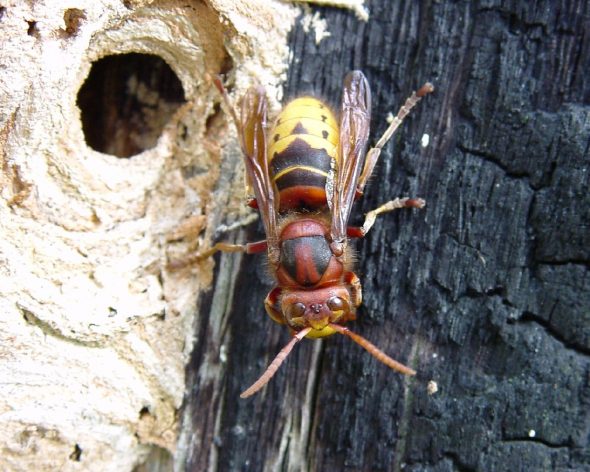
Stephanidae has a semi-circular to circular set of 3 to 5 tubercles around the middle ocellus, forming a “crown” on the head known as ocellar corona. Only one other family has a similar crown, the equally old Hymenoptera family Orussidae
Each compound eye is made up of thousands of individual eyes with lens. Yet, the three simple eyes known as ocelli are important to the insect. The image formed by the relatively large lens falls beyond the retinal layer. Thus no clear image can be received from the dorsal (middle) ocella. However it is very good at detecting the differences in light intensities. Thus it can pin-point the location of the horizon very quickly. This ability is very helpful when flying in a featureless 3 dimensional sky. Studies are being done in this area to see whether any new knowledge can be gained and adapted to help stabilise the flight of drones (unmanned aerial vehicle)
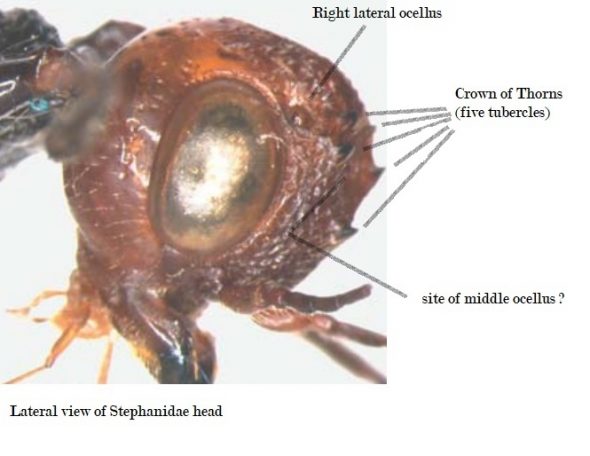
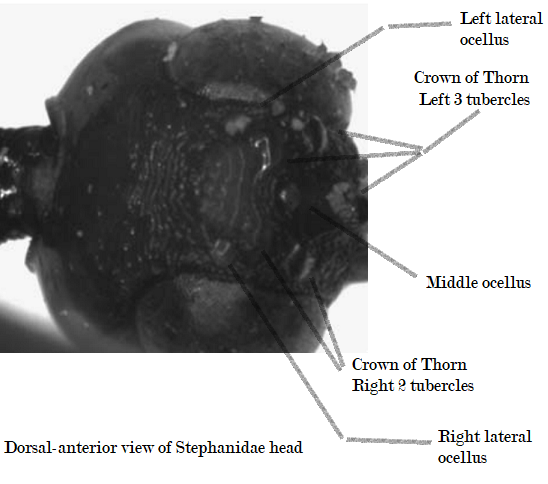
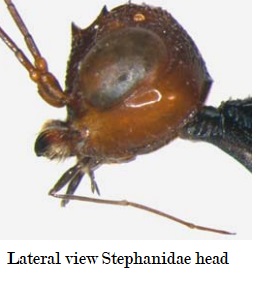
Stephanidae is known to be parasitoid on the wood boring beetle larvae of families Cerambycidae (long horn beetle), Buprestidae (Jewel beetles) and some Curculionidae (True Weevil or Snout beetles).
Stephanidae also has highly modified hind legs-swollen hind femurs with large teeth on the underside, and tibia tips that widen distinctly. The dissected hind tibia shows the presence of an apical empty space bordered by a convex membrane, obviously part of a subgenual organ (organ located in the tibias of insects involved in sound perception). Many other modifications (sturdy spurs, depressions in the chitin) seen on the front and hind legs are also thought to be sense-organs helping in the detection and determination of location of vibrational sounds. Unlike other wasps, the antennae of the Stephanidae are not adapted for tapping (i.e. to produce sound in wood). The host larvae are detected passively, by the sounds they produce while chewing on wood. These chewing sounds are intercepted by the acoustic sensors on the legs, antennae and ovipositor sheaths of the mother wasp when they in contact with the wood. Hence we can see that Stephanidae wasps have developed a highly ingenious way of using sound waves to detect and pinpoint the location of their preys hidden deep within the wood.
Stephanidae wasps may also be able to detect chemical scents given off by the beetle larvae or the beetle’s wood digesting fungus (beetles make use of fungus to soften the wood prior to mastication). This ability may help to detect and localise their prey. At least four different chemoreceptors (sensilla) have been described.
Female wasps adopt a characteristic posture when trying to locate beetle larvae in wood: fore and hind legs spread out widely, middle legs folded tightly against the body, antennae are lowered and ovipositor sheath is pressed against the wood. The insect then moves a few centimeters to a new location and repeats the process. When a potential target is located, the ovipositor bores into the wood. Boring may take many hours, with rests in between the boring efforts when the females withdraw their ovipositors. They seem to be able to re-locate the hole they were working on when they recommence boring. As the ovipositor is pushed deeper into the wood, the sheath arches upwards in a loop.
The female spends relatively little time in examination of the tree before commencement of the drilling in the stem for the oviposition. Sometimes the drilling can take up to two hours. The egg is laid on the immobilised host larva; the egg hatches within two weeks and after four to five weeks the larva metamorphoses into a pupa. The emerging adult wasp then tunnels up to the surface by gnawing through the wood. It pushes the last bit of bark away, leaving an irregular exit hole (Taylor, 1967).
Male wasps emerge approximately ten days before the females and wait for the females to surface. As many as 10 males will congregate while waiting for the females to surface. Waiting males adopt search postures similar to that displayed by females while searching for host larvae.
The parasitoid lifestyle of the wasps is humanised in the cinema show “Alien”. It gives rise to feelings of disgust, fear and cruelty. Nature is about eating and being eaten. Parasitoid wasps devour a lot of insects that are pests to human crops. Hence they are of significant benefit to man. There are many instances of parasitoid wasps being used as biological pest controller. Successful biological control of the ambermarked birch leafminer, Profenusa thomsoni (Hymenoptera: Tenthredinidae), in Anchorage, Alaska: Status 15 years after release of Lathrolestes thomsoni (Hymenoptera: Ichneumonidae)
In the next article we will look into how the parasitoid mother wasp is able to use its long and thin hair-like ovipositor to drill a deep hole in hard wood. She must also be accurate enough to hit a beetle larva to lay an egg on it.
Article by Michael Wong
Photos 3, 4 and 5 reproduced from:
van Achterberg C. (2002) A revision of the Old World species of Megischus Brullé, Stephanus Jurine and Pseudomegischus gen. nov., with a key to the genera of the family Stephanidae (Hymenoptera: Stephanoidea). Zoologische Verhandelingen Leiden 339: 1–206. [Google Scholar]
References:–
- Wikipedia – Hymenoptera, Wasp, Stephanidae,
- Journal of Natural History
- https://www.earthlife.net/insects/anat-head.html
- https://en.wikipedia.org/wiki/Polydnavirus
- https://pubmed.ncbi.nlm.nih.gov/32776656/ National Centre for Biotechnology Information.







